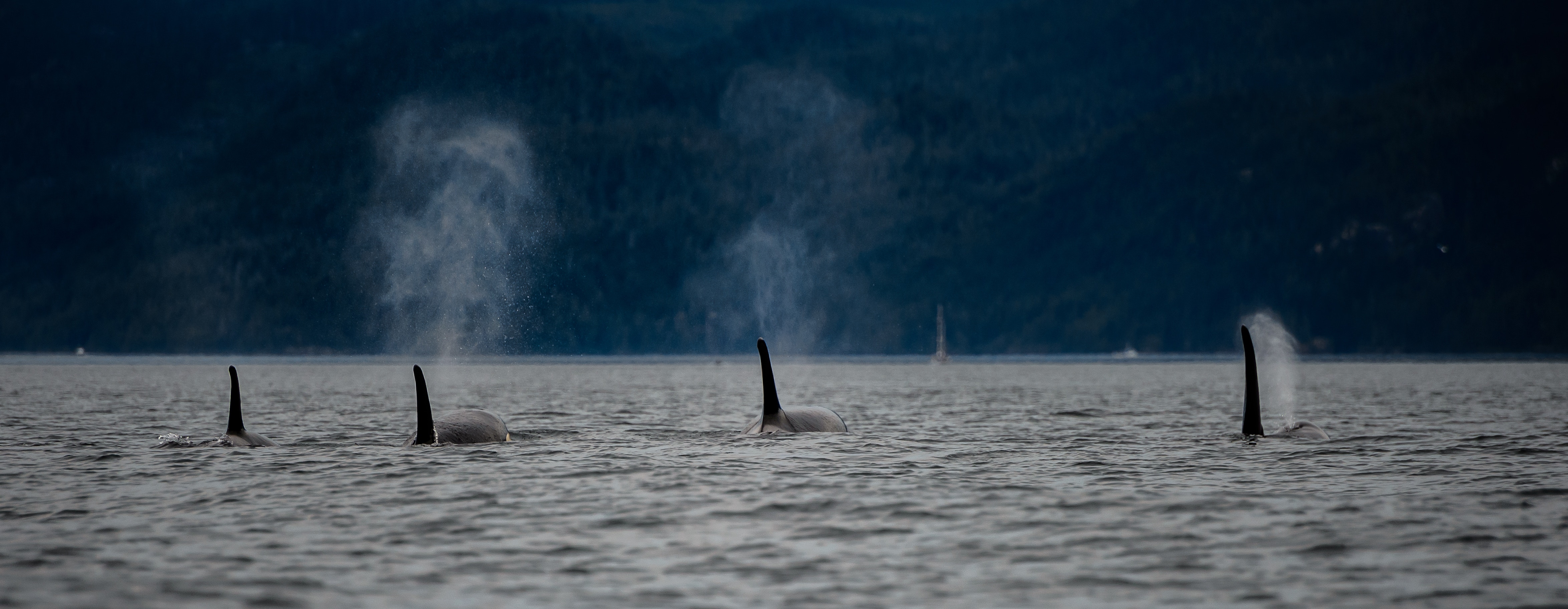The Three to Five Year Whale Watching Ban: For Conservation, or the Economy?
A significant move that will impact 32 operators, in 19 different ports in Washington State and British Columbia, is this really the answer to the dwindling Orca population?

With just 74 Orcas remaining in the waters off the coast of the State of Washington and neighbouring British Columbia, there is clearly a problem. As the Center for Whale research explains, “The Southern Resident Killer Whales (SRKW), or Orcas, are actually a large extended family, or clan, comprised of three pods: J, K, and L pods.
As of July 2018, the SRKW population totals 75 (editors note: this has since dropped to 74) whales: J Pod=23, K Pod=18, L Pod=34.”

WHAT IS EXECUTIVE ORDER 18-02?
We need to do everything we can to help ensure the future of these great animals and the State of Washington, appeared to take a great stride in March 2018.
The Executive Order, signed by The State of Washington Governor Jay Inslee, detailed that “The Task Force was charged with preparing a comprehensive report and recommendations for recovering Southern Residents, with a full draft due by September 24, 2018, and a final report by November 16, 2018”. The “Executive Order 18-02: Southern Resident Killer Whale and Recovery Task Force” can be found in full here.
The task force met that deadline, and just a couple of days ago, Governor Jay Inslee’s team voted to recommend a three to five-year moratorium on commercial whale watching for Southern Resident killer whales.
The knee jerk reaction is that this appears to be great news. If whale watching boats are causing a problem, then this is an important move to ensure their survival. However, there is more to this story and we start with the FAQ section of the Pacific Whale Watching Association’s website, where a simple questions is asked, but there is far from a straightforward answer.
ISN’T WHALE WATCHING ONE REASON THE SOUTHERN RESIDENT KILLER WHALES ARE ENDANGERED?
“There’s no evidence that whale watching is a significant factor in their decline. If that were the case, transient killer whales and humpback whales wouldn’t be doing so well in the same environment. Scientific studies on stress hormones in the southern residents show that when there’s sufficient food, boat noise and disturbance have a low effect. But when chinook salmon are scarce, as they are now year after year, and the whales have to work longer and harder to find what little food there is, any noise disturbance undoubtedly has a greater effect.”
This passage alludes to the depth that we will need to go into to establish whether this recommendation really makes that much sense.
Contrary to the Pacific Whale Watching Association's answer, Donna Sandstrom, Director of The Whale Trail, but poignantly also a member of the Orca Task Force that has made the recommendation which led to the executive order, offered another perspective entitled "Cut the toxins and boat noise, and boost salmon, so orcas can survive". Within this article, published in The Seattle Times, Donna agrees that the "best available science shows that to recover the orcas we must both increase the amount of salmon" but that a decrease in the amount of noise is necessary too. Within the same article a study is referenced, "that shows that the southern residents lose 5.5 hours of foraging time each day due to noise and disturbance from commercial vessels and whale-watching boats specifically".
Elsewhere, Elizabeth May, the leader of the Green Party of Canada tweeted.
please ramp up enforcement. Washington State does a much better job protecting our SRKW from whale-watch boats harassment. #GPC #SRKW #orca https://t.co/scNKzVInMW
— Elizabeth May (@ElizabethMay) November 2, 2018
HOW DOES U.S. LEGISLATION EFFECT CANADIAN COMPANIES?
With this Executive Order being passed in the State of Washington, you might be asking yourself why this might influence Canadian ports and Whale watching companies? As far as we're aware at The Outdoor Journal, there are not any planned Canadian recommendations, legislation or any kind of moratorium.
Brett Soberg, who runs Eagle Wing tours but also speaks on behalf of British Columbia's whale watching industry told Global News that “The whale-watching industry is a trans-national. Canadian companies are regularly in American waters tracking animals. If Washington state bans viewing it will have an impact on how Canadian tour operators conduct their business, but there are very few details about what could happen. This really surprised us.”
THE DAMS AND LACK OF SALMON, THE BOATS, OR BOTH?
"Honesty was crushed by politics and vested interests, even within agencies whose responsibility it is to manage natural resources sustainably."
These are the words of Ken Balcomb, executive director of the Center for Whale Research. These feelings are echoed elsewhere by many activists who feel that this decision to target commercial whale watchers is skirting the key issue of dams cutting off the Orca's food supply. Put simply, Salmon cannot make their way down the rivers due to huge dams that "produce an average of 1,000 megawatts of power a year, or about 5 percent of electricity generated in the Pacific Northwest, and account for about 12 percent of BPA's power", according to K5 news. A huge amount of power, that has a huge amount of commercial and therefore political value too.
they overwhelmingly rely on Chinook salmon"
National Geographic published an article that spells out the importance of Salmon to the SRKW's in their article "How Killer Whales Went from Hated, to Adored, to Endangered". Nat Geo explain that "What’s hurting them is, above all, the lack of available prey" and that "Southern Residents don’t just rely primarily on Chinook salmon; they overwhelmingly rely on Chinook salmon".
Elsewhere, Mark Sawyer, a Whale watching guide for Jamie's Whale Watching Tours posted the below on Instagram.
Brett Soberg, told Global News that “It’s pretty clear food scarcity, not noise from boats that is the biggest concern to the southern residents”. The situation does appear bizarre, that a few whale watching boats are being deemed an issue, whilst huge tankers and all the pleasure boats are not considered to be a more significant concern.
Are the politicians willing to hinder short-term economic gain for long-term environmental benefit?
Andrew Trites, of the University of British Columbia, where he is the Director of UBC's Marine Mammal Research Unit, supported this observation, when he told CTV news that "Nothing's being talked about for all the small pleasure boaters that are roaring around". Andrew continues to explain that "We don't ever talk about what's happened to the food supply… The irony is that the whale-watching industry that takes out many, many people in each boat, they know the whales better than anybody else". Elsewhere, Mark Malleson, the Prince of Whales, also told CTV that "Many of us are taking photographs, collecting data, so a huge attribute for the scientific community".
The Orca Behaviour Institute has also argued that commercial whale watching should not be be considered a huge problem in comparison barge traffic and commercial fishing boats.
FURTHER DOWN THE RABBIT HOLE
There are further explanations as to why the population of Southern Resident Killer Whales is dwindling. For many years, they were taken out of their natural habitats to be kept in captivity. It all started in the 60's with Ted Griffin, a well known personality in Seattle as the founder of the Seattle Marine Aquarium. Ted brought the SRKW's to his park, and as far as we know, became the first person to swim with one. Ted's impact on the SRKW's really solidified over coming years, as he went on to repeat this again and again, capturing dozens in order to satisfy the demand from aquariums around the world.
Jenny Atkinson of the Whale Museum told Advocacy for Animals, that “Originally, the main threat that everybody believes is what really caused this population decline was that capture era, where more than 50 individuals were taken out of this population for the captive industry.” Due to ease of transportation, it was often the smaller Whales that were taken, this meant that two generations of Southern Resident's were removed from the oceans. Not only did this leave the pods with the obvious problem, but also a reduction in diversity within the gene pool. Ted's legacy is that of a lasting threat to the existence of Southern Resident Killer Whales.
There are also curious examples from other geographic regions, that it's important to take note of. The Government of Canada note that the "Northern Resident population has grown since the 1970s. Since 2002, the population has experienced an average annual growth rate of 2.9%. In 2017, the population numbered 309 individuals. However, conservation concerns exist for this population, given its small size and slow growth rate." In the 1970's, the population stood at 120, so there has clearly been a huge improvement in an area so close to the waters frequented by the Southern Residents.
The 2017 Northern Resident #KillerWhale numbers are in – this population has grown to a maximum of 309 whales! This number includes 5 confirmed whale deaths and 10 calves born. Find out more: https://t.co/PA1zFgK4Ii pic.twitter.com/vp1waWvOlo
— DFO Pacific (@DFO_Pacific) May 11, 2018
Why is this? How can the difference be so big between the Northern and Southern Residents? Lance Barrett-Lennard, director of the marine mammal program at the Vancouver Aquarium told the Haida Gwaii Observer that whilst the growth has been encouraging “They took a bit of a downturn in the late 1990s, during a time when chinook salmon were particularly scarce in some poor salmon years”. It's a very interesting observation, and links can surely be drawn with the issues that the SRKW's face. In times where the Salmon is plentiful the Northern Resident population has grown substantially.
AN ATTEMPT TO DRAW CONCLUSIONS
This is clearly a complex issue, and it's very difficult to draw clear conclusions. However, it's obvious that most people who understand the situation and Orca's better than anybody agree that food scarcity is the main issue. This is backed up by the success of the Northern Residents, who have had a sufficient source of food for a sustained period.
The resolution to conserving the Southern Residents means increasing salmon populations, but to do so would require drastic measures. A good example would be the removal of dams on the Snake River, which would ensure that greater numbers would be within range of the Orca's. However, the removal of dams on the Snake River could mean a detrimental effect on the economy, a move that appears unlikely, even if it is in the face of huge environmental importance. Instead, recommendations to skirt this issue, and target whale watching tours is likely to continue, so that politicians can be seen to be doing something whilst protecting the economy over the conservation.
As Mark Sawyer of Jamie's Whale Watching asks, the important question appears to be whether "the politicians willing to hinder short-term economic gain for long-term environmental benefit?"
Cover Photo by Robert Pittman





Comments ()